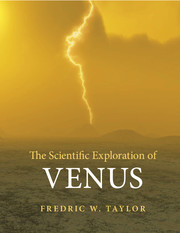Book contents
- Frontmatter
- Contents
- Overview
- Prologue
- A note on scientific units
- Acknowledgements
- Part I Views of Venus, from the beginning to the present day
- Chapter 1 The dawn of Venus exploration
- Chapter 2 Mariner and Venera
- Chapter 3 Pioneer Venus and Vega
- Chapter 4 Images of the surface
- Chapter 5 The forgotten world
- Chapter 6 Earth-based astronomy delivers a breakthrough
- Chapter 7 Can’t stop now
- Chapter 8 Europe and Japan Join In
- Part II The motivation to continue the quest
- Part III Plans and visions for the future
- Epilogue
- References and acknowledgements
- Appendix A Chronology of space missions to Venus
- Appendix B Data about Venus
- Index
- Plate section
Chapter 7 - Can’t stop now
Galileo and Cassini fly past Venus
from Part I - Views of Venus, from the beginning to the present day
Published online by Cambridge University Press: 05 September 2014
- Frontmatter
- Contents
- Overview
- Prologue
- A note on scientific units
- Acknowledgements
- Part I Views of Venus, from the beginning to the present day
- Chapter 1 The dawn of Venus exploration
- Chapter 2 Mariner and Venera
- Chapter 3 Pioneer Venus and Vega
- Chapter 4 Images of the surface
- Chapter 5 The forgotten world
- Chapter 6 Earth-based astronomy delivers a breakthrough
- Chapter 7 Can’t stop now
- Chapter 8 Europe and Japan Join In
- Part II The motivation to continue the quest
- Part III Plans and visions for the future
- Epilogue
- References and acknowledgements
- Appendix A Chronology of space missions to Venus
- Appendix B Data about Venus
- Index
- Plate section
Summary
Earth-based spectroscopic studies of Venus flourished for a while as planetary astronomers exploited the newly discovered infrared windows. In particular, when these were combined with the data from the earlier space missions, a more complete picture of the atmospheric environment on Venus began to appear.
The success of the telescopic observers served to emphasise the strong argument for taking the powerful technique of spectral imaging in the ‘windows’ to Venus on the close and versatile platform offered by a spacecraft. As we have seen, none of the Mariner or Venera spacecraft had this capability, and we Pioneer Venus investigators naïvely failed to make and exploit a major discovery by not using its near-infrared capability on the nightside to detect the emission from the deep atmosphere.
By 1989, NASA was preparing the Galileo Jupiter orbiter spacecraft for launch. Galileo was to reach Jupiter by means of close flybys of Venus and Earth, and would reach Venus in February 1990 (Figure 7.1). As it happened, the Jupiter orbiter carried an instrument perfectly suited for observing Venus, the Near Infrared Mapping Spectrometer (NIMS). Those of us on the Galileo team who were also interested in Venus science quickly calculated that NIMS could achieve a spatial resolution on Earth’s neighbour that was far better than the Earth-based near-infrared images. Also, it had a spectral range that overed all of the known and predicted windows.
- Type
- Chapter
- Information
- The Scientific Exploration of Venus , pp. 87 - 96Publisher: Cambridge University PressPrint publication year: 2014



